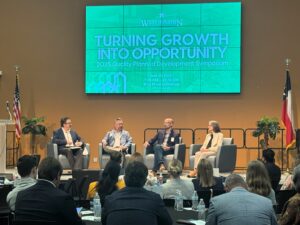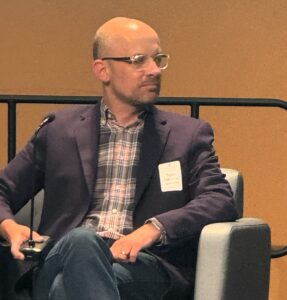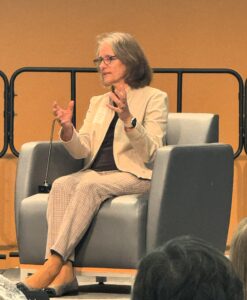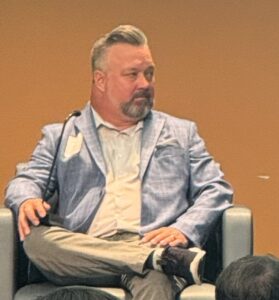 The final panel of our 2025 QPD Symposium tackled one of the most loaded concepts in modern land development — Density. “We don’t say the Z-word,” Chris Browne of EHRA Engineering joked at the start, referring to zoning, and “the D-word” can trigger similar fears.
The final panel of our 2025 QPD Symposium tackled one of the most loaded concepts in modern land development — Density. “We don’t say the Z-word,” Chris Browne of EHRA Engineering joked at the start, referring to zoning, and “the D-word” can trigger similar fears.
Long a source of public anxiety and policy contention, density is often misunderstood as a one-size-fits-all formula. But as this session made clear, the question isn’t whether density is good or bad. The question is how we design for it thoughtfully, flexibly, and in a way that reflects how people want to live.
Moderated by Browne, the discussion brought together Marlene Gafrick with the City of Houston, Todd Hamilton with the Signorelli Company, and Ryan White with Highland Homes, to explore what “density done well” looks like in practice.
This panel focused on reframing density not as a rigid typology, but as an evolving toolkit to build stronger, more diverse communities. Gafrick, a longtime public servant and planner, reminded the audience that many master planned communities (MPCs) are essentially “city building.” They include all the ingredients of a functioning urban system: homes, retail, green space, infrastructure, and public services.
What makes that community successful, panelists agreed, is not just the unit count per acre but the intentionality behind it.
 At Austin Point, a 4,000-acre MPC rising near Richmond-Rosenberg, Hamilton and his team are testing what it means to offer “something for everyone.” That doesn’t mean cramming in as many small lots as possible, but rather providing a genuine mix: from alley-loaded cottages to multigenerational homes, all woven into a walkable, human-scaled environment.
At Austin Point, a 4,000-acre MPC rising near Richmond-Rosenberg, Hamilton and his team are testing what it means to offer “something for everyone.” That doesn’t mean cramming in as many small lots as possible, but rather providing a genuine mix: from alley-loaded cottages to multigenerational homes, all woven into a walkable, human-scaled environment.
“Phase one alone includes 12 different home offerings across nine builders,” said Hamilton. “Thirty percent of those are alley-loaded. That kind of range attracts a broader segment and creates a more complete place where people can connect.”
White, with 30+ years of design experience, echoed the need for variety. Drawing on demographic insights, he noted that only about 25% of homebuyers are first-timers, yet much of the “attainability” conversation tends to focus on entry-level price points. Millennials, empty nesters, dual-income households without kids, and baby boomers “chasing grandkids” all have different needs, and a true MPC should account for that.
“Designing for space count rather than just bed and bath count allows for more flexible homes that reflect how people live now,” said White. A 6×8 room might not qualify as a bedroom, but it could be the perfect workout room or home office while still offering the same value in livability to the homeowner.
If higher density homes give up square footage, they need something in return: community, connection, and convenience. That’s why Austin Point’s first amenity isn’t a splash pad or pool; it’s a gathering hub with a coffee/wine bar, lawn, exploratory play space, and covered porch. A “third place,” as other panels discussed, encourages interaction and provides an anchor for the neighborhood.
Panelists emphasized that open space must be thoughtfully located, not just quantity checked. “If it’s across the community and you need to drive to it, that defeats the purpose,” White said. “We need green space that people interact with daily—pocket parks, trails, social areas right outside your front porch.”
That front porch is making a comeback. Hamilton noted that over 60% of homes submitted in Austin Point’s first phase include a front porch with many oriented toward shared green spaces rather than private backyards. “It’s not just about the backyard anymore,” he said. “We’re designing for people to live out the front of their homes.”
 All three panelists agreed that doing density well means challenging long-standing norms. In many outlying counties, minimum lot sizes and frontage requirements persist that make thoughtful design difficult. These rules may be intended to preserve a certain character, but as Gafrick pointed out, they often stifle innovation and prevent communities from evolving.
All three panelists agreed that doing density well means challenging long-standing norms. In many outlying counties, minimum lot sizes and frontage requirements persist that make thoughtful design difficult. These rules may be intended to preserve a certain character, but as Gafrick pointed out, they often stifle innovation and prevent communities from evolving.
“We need to ask: Why are we doing things this way?” she said. “Is it because it’s always been done like that, or because it’s actually the best way?”
Jurisdictions can help or hinder progress. Developers need flexibility, but they also need partnership. “We’ve reduced the number of cul-de-sacs and worked with the county to allow for shortened block lengths, narrow streets, , and face homes to green space,” Hamilton shared. “But that only works when there’s open dialogue.”
Panelists also addressed what happens after the initial buildout. Maintaining quality over time is a real concern, especially when developers exit and responsibility passes to homeowners’ associations and MUDs.
Hamilton praised models where fees from home transactions fund long-term improvements or new amenities, ensuring the community can adapt to future needs. “You don’t know what maintenance in the fifteenth year of a community is going to look like,” he said. “But you want to have the flexibility, and the capital, to respond.”
Gafrick added that with Houston’s annexation authority curtailed, it’s even more important for MUDs to be equipped to make infrastructure investments down the line. That means thoughtful planning from the outset.
 Perhaps the most compelling idea was that successful communities are built not just for the people who buy first, but for those who come after.
Perhaps the most compelling idea was that successful communities are built not just for the people who buy first, but for those who come after.
“You’re not just designing for who’s going to live there today,” said White. “You’re designing for their kids, their parents, their changing lifestyles.”
And that future will continue to bring pressure: rising land costs, shifting family dynamics, changing buyer expectations, and evolving mobility needs. Cities, counties, and developers alike need to be proactive, adaptive, and collaborative.
“Density isn’t about cramming people in,” said Browne in closing. “It’s about getting the right mix of people, places, and design so that what we build today still works 20 years from now.”
